Including an up-close look at the still wet and warm pellet.
Yesterday was an unusually buggy morning on Antelope Island (midges, biting gnats and a few mosquitoes) so I doused myself with insect spray and usually didn’t stop for birds unless the situation looked highly promising. So I’m surprised I stopped for this Loggerhead Shrike because ‘he’ wasn’t very close and he was perched on top of a poop-covered pavilion. But with birds you never know what might happen and this time I was rewarded with an unexpected behavior.
This series is documentary quality only. The photos have been cropped significantly and the shrike was side lit so I only got a catch light in his eye in two of the photos in the series.
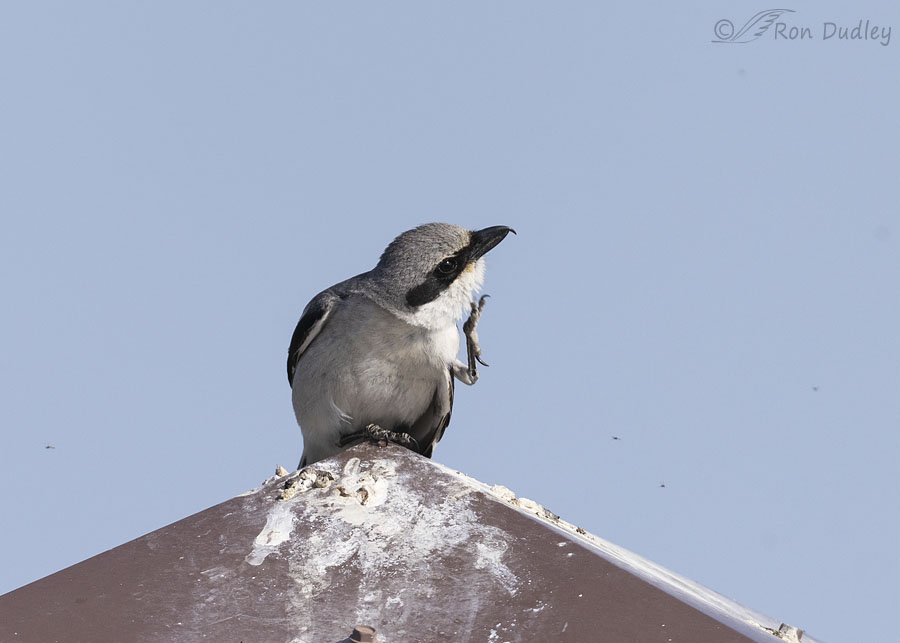
This is the very first photo I took of him out of many. The only reason I got a catch light in his eye is because he turned his head while scratching his neck.
Note: I’ve seen this neck-scratching behavior quite a few times before, just prior to the bird throwing, or attempting to throw, a pellet. Which makes me wonder if neck scratching is done deliberately in an attempt to help move the pellet up the throat.
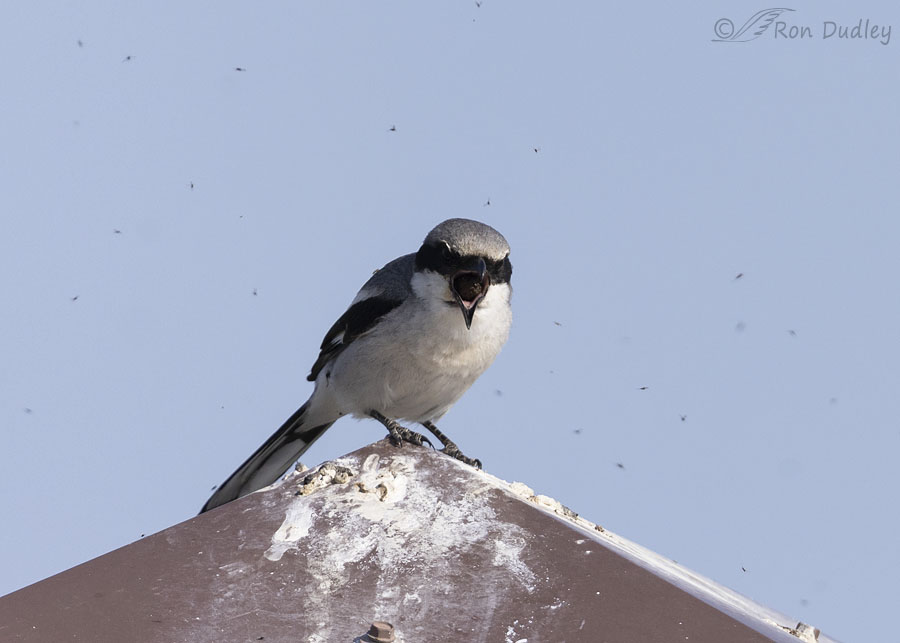
He was surrounded by tiny flying insects, gnats (no-see-ums) I believe because they’re too small to be midges. When he suddenly and without warning opened his mouth without making sound I initially thought he was attempting to snag insects out of the air, like many songbirds do. But it turned out that he was beginning the process of casting a pellet. If you look closely you can see the pellet beginning to emerge from his mouth.
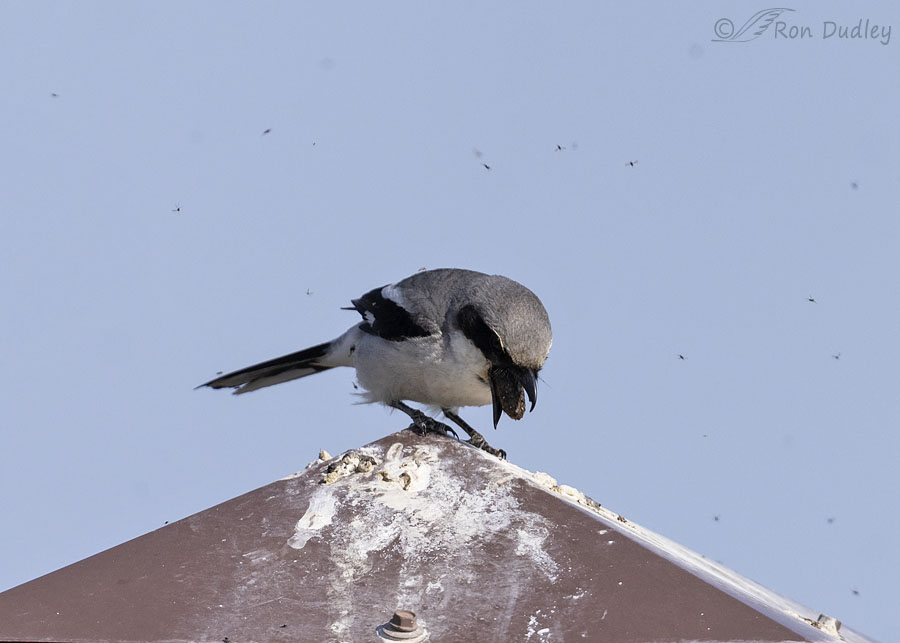
Here the emerging pellet is more easily seen.
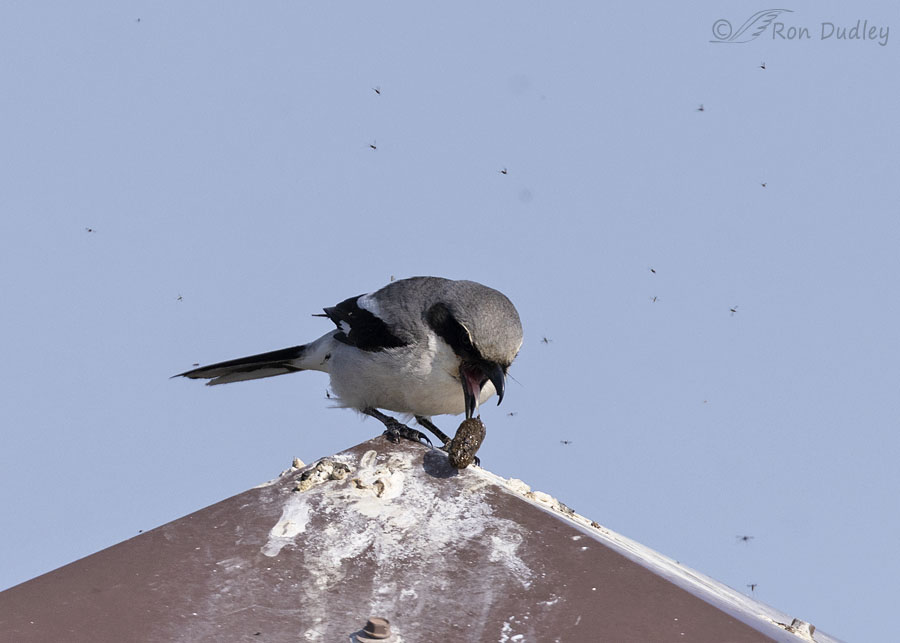
It fell from his mouth and hit the peak of the pavilion roof. I expected it to roll down the steep roof and fall to the ground but…
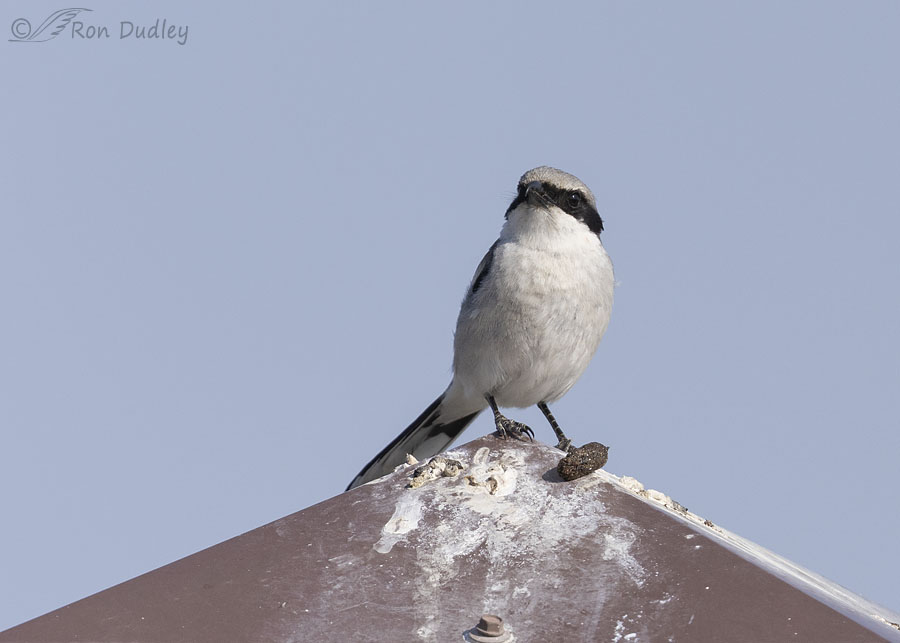
it stuck right where it landed, probably because it was wet and somewhat sticky.
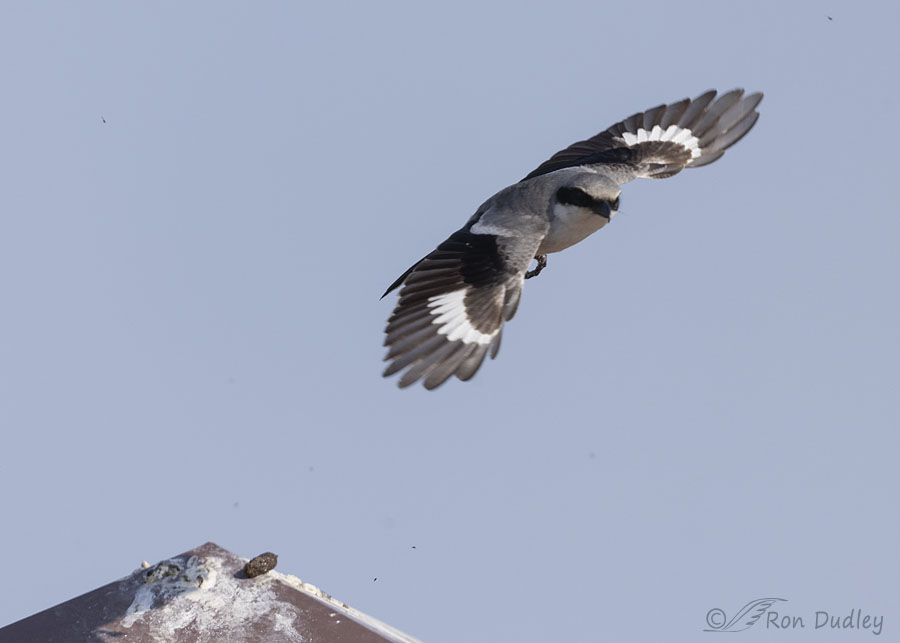
Almost immediately the shrike flew off, leaving the pellet stuck to the roof.
I was shooting from the campground road and realized that I could get a closer look at the pellet on the roof if I backed up my pickup and pulled into the actual (empty) campsite. So that’s what I did.
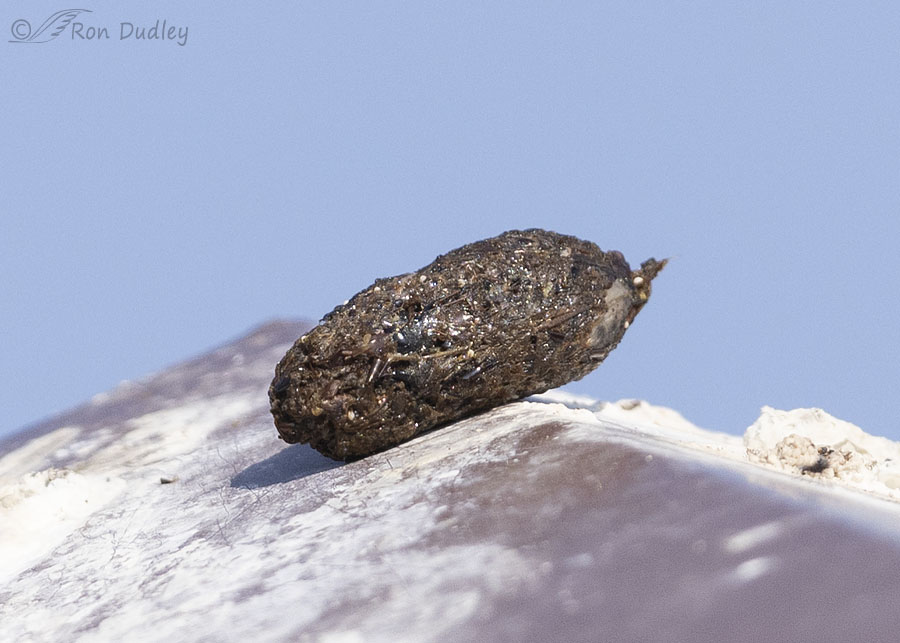
The diet of Loggerhead Shrikes includes Arthropods, amphibians, small to medium-sized reptiles, small mammals and birds. If I had to guess, based on the appearance of this pellet, I’d say this particular shrike has been eating insects primarily. Maybe exclusively.
On the other hand, there may be some mammal fur in there too. Shrikes on the island sometimes prey on voles.
Cornell’s Birds of the World reports the following about Loggerhead Shrike pellets:
- “Pellets produced by caged Loggerhead Shrikes during arthropod-feeding experiments contained cuticular remains only when hard-bodied insects were fed, but none when soft-bodied insects were ingested. This indicates that pellet analysis can yield at best only partial information about dietary intake in shrikes.”
- “Pellet formation, from the time prey is ingested until the compacted pellet is egested, averages 35.5 min.”
In the past when I’ve seen pellets cast by songbirds the pellets have always fallen to the ground, usually in the middle of a thicket of brush and bushes, so I’ve never had such an up-close look at a fresh shrike pellet.
Curiosity satisfied.
Ron


You did it again Ron. This morning I have been both fascinated by your photographs and educated. The teacher in you is alive and well.
I am embarrassed to say that I thought only hawks, falcons and owls regurgitated pellets. Just got done Googling it and saw that there are many more that do so.
Always enjoyed watching Shrikes. They have such a purposeful and distinctive wing beat and flying style. They are good looking too.
Thanks very much, Michael. If I had to guess I’d say that I’ve photographed about a dozen species of songbirds and shorebirds casting pellets.
And you’re right about the distinctive wingbeat of shrikes. When I see one in flight that’s too far away to ID by its field marks, I can often tell it’s a shrike by the way if flies (its wingbeat).
Definitely better out than in. And I would scarper if I had thrown up something like that too.
EC, ignorant me had to look up “scarper”. I thought it would be some obscure (to me) Australian term but apparently it isn’t.
The sacrifices you make for your art—I am impressed and amazed (and slightly repelled by the thought of all those insects and all that repellent)! Interesting close-up of that fresh pellet, I imagine the shrike feels great relief at having upchucked it.
“I imagine the shrike feels great relief at having upchucked it.”
I suspect you’re right, Chris. I’m sure glad we don’t have to upchuck stuff we can’t digest, in addition to defecating.
Great lesson. So many people think that only owls cast pellets. I’ve had someone insist that if any bird but an owl cast a pellet it would be very sick. The forward portion of the stomach (proventriculus) is much less acidic in owls so bone is not dissolved and they have much fuller and tightly compacted pellets containing undigested bone, feathers and fur. It’s fun for students to open and find often complete skeletons. A shrike or bluebird pellet would probably be less interesting but a good educational experience.
Dan, I remember the first owl pellet I dissected many years ago. It was exciting to find a single, tiny mammal mandible, with teeth. Based on its incisors it obviously came from a small rodent.
I appreciate that you are willing to bring up (pun intended) subjects that most would avoid. I’ve learned more about pellets and poop from FP than I would have expected. Among many other things, of course.
Thanks, Lyle. I see absolutely no reason to avoid them.
What an interesting series! The straight-on second photo is amazing. The size of the pellet in comparison to the bird, very impressive.
Do you know if magpies also cast pellets? I watched one yesterday, moving very restlessly around the tree branches, beak wide open the whole time. It might have been panting, but it looked different, like it had something stuck in its mouth. Like this shrike!
Yes, Black-billed Magpies cast pellets, Carolyn. Here’s what Cornell has to say about it:
“Pellet formation depends to some extent on diet, but it is thought to be widespread in magpies, if not an obligatory activity. Numerous pellets described below nests and roosts; size roughly 1.3–1.9 cm; some pellets are filled with beetle (Coleoptera) wings or a few mice and mole skulls. Magpies may deliberately swallow hair when they land on backs of cattle and wild ungulates, perhaps to aid pellet formation.”
Question is whether you’ll poison youself before the gnats or not! 😉 Only pellets I’ve ever seen are owls which are interesting…… Not interested in watching the process as my peristalic action tends to want to “mimic” it….
“Funny” a couple of days ago – a beaver making it’s way upstream through the flooded willow brush and a drake mallard up it’s ass for, maybe, a quarter mile…… 🙂
Wow, Judy. Maybe the Mallard was trying to herd the beaver out of the area.
Could be – know there’s a nest over there “somewhere”……..always something new…. 🙂
When you mentioned the neck-scratching maneuver as a possible assist
to bringing up a pellet, it reminded me of advice I’ve had about helping a
pet cat who’s having difficulty expelling a hairball– the advice being to stroke
its throat in an upward direction…..glad we humans don’t often have this
challenge !
Interesting about the cat Kris. I’m thinking more strongly that’s why birds do it prior to throwing a pellet.
OK, now I can answer your question from a couple of days ago. Just the thought of an insect triggers an “itch” reflex in me. I’m sure it’s psychological. It doesn’t matter if the insect is one that will bite or not. So, yeah. When I read your second sentence, my skin started to jump.
Ever the biology teacher, aren’t you!! Interesting post, if a bit “icky”
Thanks, Sue. In my view, “interesting” when combined with “icky”, is a great combination!
Sorry to be the source of your skin crawling. Have another one of your birthday cakelets as a possible antidote. As I recall they’re chocolate and chocolate can perform miracles…
Maybe history’s first closeup of a Loggerhead’s regurgitated pellet. Great shot and educational story. Wow – looking at these photos you definitely need lots of insect repellent to be out there.
Everett, the repellant works well with mosquitos but only marginally with biting gnats and only when it’s freshly applied. So I have to keep dousing myself every half hour or so. The midges don’t bite or sting but those damn gnats in my hair drive me crazy. Thankfully I don’t react to gnat bites like a lot of people do, with oozing, itching sores that last for days.